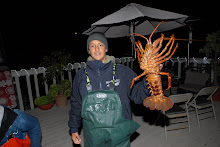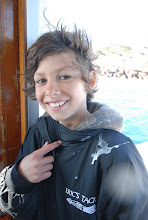
The Swordfish in Chumash Prehistory
John R. Johnson, Ph.D.
Curator of Anthropology, Santa Barbara Museum of Natural History
The fascination that the swordfish held for the Chumash is well documented in myth, art, oral history, and material culture. The Swordfish Dance was an important part of Chumash ceremonies, and at least three rock art sites contain explicit depictions of this species. Swordfish remains are found frequently in archaeological sites along the Santa Barbara Channel, and certain nonedible parts of the fish's anatomy were modified for both ceremonial and utilitarian purposes. New studies based on museum collections help us reconstruct the prehistory of the Chumash swordfish fishery and correlate its development with technological and environmental changes.
According to Chumash tradition, all the creatures of the sea had counterparts on the land. For example, the Chumash considered the sardine to be like the lizard; and the lobster, like the Jerusalem cricket ("potato bug"). People venerated the swordfish as "people of the sea" - marine equivalents of human beings. They believed swordfish drove whales ashore to provide plentiful food for the people on land. Marine biological literature documents that a factual basis lies behind this Chumash legend, because there are reports around the world of swords embedded in stranded whales.
Frequently both swordfish skeletal remains and finished artifacts made from these remains have been recorded from archaeological sites throughout the Santa Barbara Channel region. The Chumash modified swords, vertebrae, and vertebral spines for digging implements, cups, and needles. They made headdresses from the swordfish cranium and decorated them with abalone ornaments for dances.
Swordfish remains first appeared in 2,000-year-old archaeological deposits in the Santa Barbara region. Prior to this time, they have been notably absent in collections from both island and mainland sites. The advent of successful Chumash swordfishing appears simultaneously with two technological innovations: the plank boat (or tomol) which allowed for greater mobility and speed, and the barbed harpoon foreshaft that could be thrust into the fish when it "basked" near the surface in calm waters.
It seems logical that most finds of swordfish skeletal parts might be recovered in island and mainland deposits nearest the places known today as the best fishing areas, but the data only partly support this expectation. The distribution of archaeological sites containing swordfish remains extends beyond the current area of the most productive fishery. According to commercial fishermen, swordfish today rarely enter the main part of the Santa Barbara Channel, yet their remains have been recovered from many prehistoric middens between Ventura and Gaviota.
Climatic changes may account for the differences between the archaeological record and modern observations. Based on analyses of sediment cores, the reconstructed sea temperature curve for the Santa Barbara Basin shows that channel waters have been cooler during the most recent 900 years than they were during the preceding millennium. Most swordfish remains in the Santa Barbara Museum of Natural History collection are from archaeological sites dating between 2,000 and 900 years ago when sea temperatures were mostly warmer in the channel. This discovery illustrates how archaeological finds may provide additional information about past environmental conditions as well as illuminate Chumash cultural history.







.jpg)



















No comments:
Post a Comment